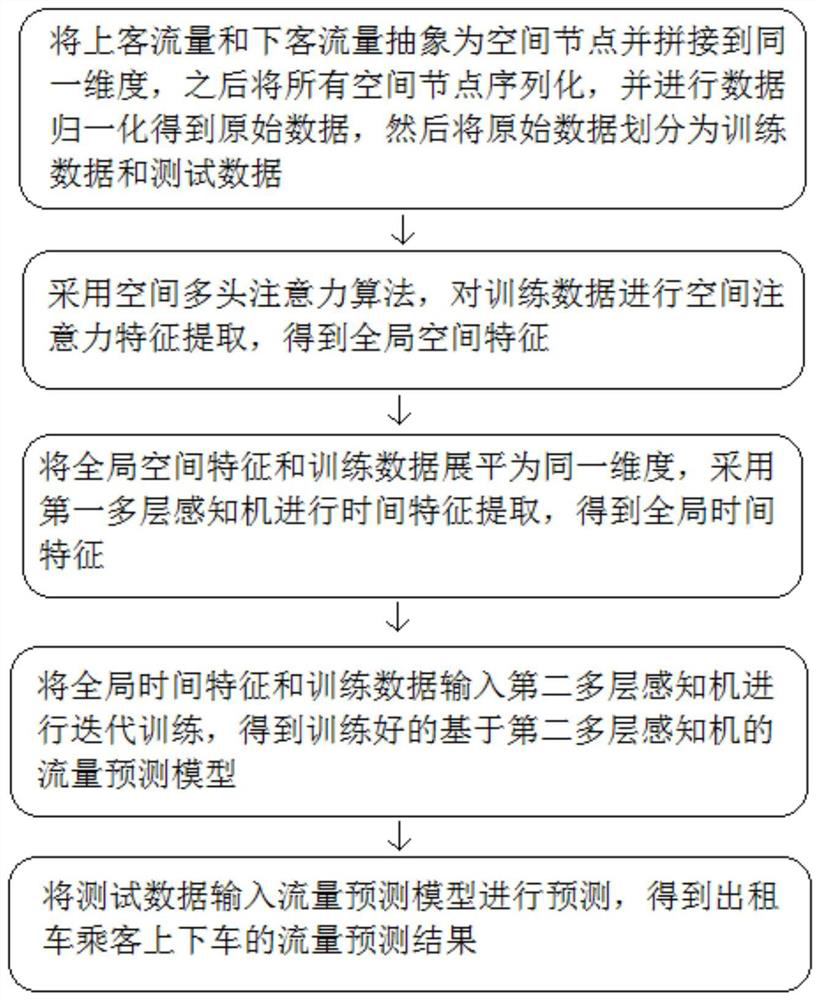Taxi passenger flow prediction method
A technology for passenger flow and forecasting methods, applied in forecasting, data processing applications, instruments, etc., can solve the problem of difficulty in effectively extracting the correlation of spatial features of data, and achieve the effect of high-precision forecasting
- Summary
- Abstract
- Description
- Claims
- Application Information
AI Technical Summary
Problems solved by technology
Method used
Image
Examples
Embodiment 1
[0043] Such as figure 1 As shown, a taxi passenger flow prediction method includes the following steps:
[0044] S1: Abstract passenger flow and passenger flow into spatial nodes and stitch them into the same dimension, then serialize all spatial nodes and normalize the data to obtain the original data, and then divide the original data into training data and test data;
[0045] S2: Use the spatial multi-head attention algorithm to extract spatial attention features from the training data to obtain global spatial features;
[0046] S3: Flatten global spatial features and training data into the same dimension, use the first multi-layer perceptron to extract temporal features, and obtain global temporal features;
[0047] S4: Input the global time feature and training data into the second multi-layer perceptron for iterative training, and obtain the trained traffic prediction model based on the second multi-layer perceptron;
[0048] S5: Input the test data into the flow predi...
Embodiment 2
[0078] In this embodiment, each step of the taxi passenger flow prediction method in the above-mentioned embodiment 1 can also be integrated into different modules and realized through the system, and a taxi passenger flow prediction system is designed.
[0079] The system includes a data processing module, a spatial feature extraction module, a time feature extraction module, and an output module sequentially connected by communication;
[0080] The data processing module is used to abstract the passenger flow and passenger flow into spatial nodes and stitch them into the same dimension, then serialize all the spatial nodes, and perform data normalization to obtain the original data, and then divide the original data into training data and test data;
[0081] The spatial feature extraction module is used to extract the spatial attention feature from the training data by adopting the spatial multi-head attention algorithm to obtain the global spatial feature;
[0082] The tem...
Embodiment 3
[0086] The platform implemented in this example is: the processor is Intel i7-8700, the memory is 32.0GB; the graphics card is GTX3070; the system is Windows10 (64-bit); the programming language version is Python3.6, and the deep learning algorithm is implemented in the Pytorch learning library. A method for predicting taxi passenger flow, comprising the steps of:
[0087] Step S1. The data source of this embodiment is the passenger flow of taxis in a certain area of New York City. The area is divided into 266 grids. At the same time, the pick-up node and the drop-off node are abstracted and spliced into the same dimension to form 532 spatial nodes. All spatial nodes are serialized, and the traffic acquisition time interval of all nodes is 30 minutes, and the original data is normalized by using the dispersion standardization method;
[0088] The normalization method is as follows:
[0089]
[0090] where x s is the processed data, x is the input data, X max is the m...
PUM
 Login to View More
Login to View More Abstract
Description
Claims
Application Information
 Login to View More
Login to View More - R&D
- Intellectual Property
- Life Sciences
- Materials
- Tech Scout
- Unparalleled Data Quality
- Higher Quality Content
- 60% Fewer Hallucinations
Browse by: Latest US Patents, China's latest patents, Technical Efficacy Thesaurus, Application Domain, Technology Topic, Popular Technical Reports.
© 2025 PatSnap. All rights reserved.Legal|Privacy policy|Modern Slavery Act Transparency Statement|Sitemap|About US| Contact US: help@patsnap.com



